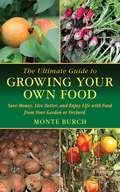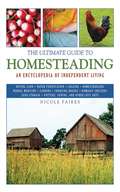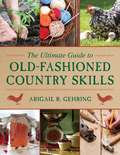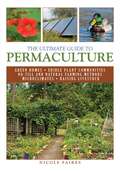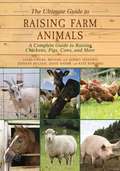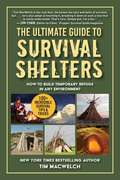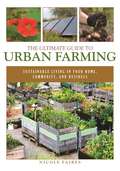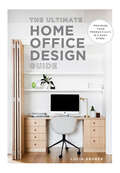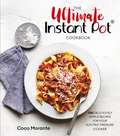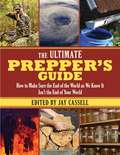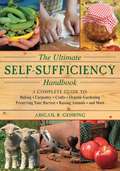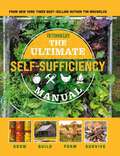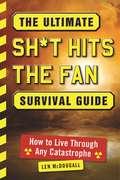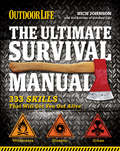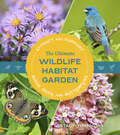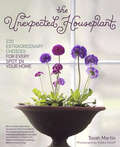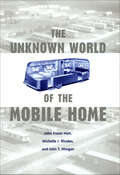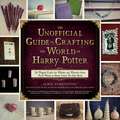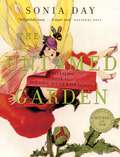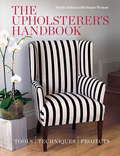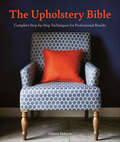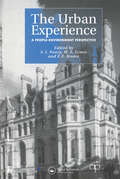- Table View
- List View
The Ultimate Guide to Growing Your Own Food: Save Money, Live Better, and Enjoy Life with Food from Your Garden or Orchard (Ultimate Guides)
by Monte BurchGrowing your own food is a hot topic today because of the high cost of transporting food long distances, the heightened problem of diseases caused by commercially grown foods, and concerns of the overuse of chemicals in mass food production. Many people--from White House executives to inner-city kids--have recently discovered the benefits of homegrown vegetables and fruits. Community gardens, and even community canning centers, are increasingly popular and have turned roof-top gardening into a great and healthy food source. And on a smaller scale, some plants can even be grown in containers for the smallest backyard or patio. The possibilities for growing your own food are endless! The Ultimate Guide to Growing Your Own Food informs you how to grow all types of vegetables, fruits, and even grains on your own land or in any small space available to you and your family. Also included is information on specific health benefits, vitamins, and minerals for each food, as well as detailed instructions for fall and winter food growing. Learn how to grow for your family, harvest and store all types of home-grown produce, and find joy in eating foods planted with your own hands.
The Ultimate Guide to Homesteading: An Encyclopedia of Independent Living (The Ultimate Guides)
by Nicole FairesCan you make your own bread (sans bread machine)? Grow a garden all winter? What can you use instead of toilet paper? What if the power went out for a month? What if the grocery store closed? Can you make a solar oven? Store food without electricity? Raise a water buffalo? Make fine linen from stinging nettle? Make your own shampoo? Deliver a baby? Is it possible to be totally self-sufficient? This massive, full-color book answers all these questions and thousands more and includes checklists, diagrams, and instructions on how to buy a sheep. All of the information included meets these criteria: It is something that anyone can do, without special training. It can be done with relatively few supplies or with stuff you can make yourself. It has been tried and tested--either by the author, the military, doctors, or other homesteaders. The Ultimate Guide to Homesteading is not a storybook or a cookbook. It is a practical guide with nitty-gritty details on everything a homesteader can do, step-by-step with hundreds of color illustrations and pen and ink sketches. You can do it! This book can help.
The Ultimate Guide to Nautical Knots: 22 Sailing And Boating Knots
by Skyhorse PublishingA Practical and Visual Guide to the Essentials of Marine Knots! Every good sailor must know the basic knots, indispensable for his safety and life on board in general. This handy little manual offers you the opportunity to master the essentials of knot-tying, with clearly illustrated step-by-step instructions. The Ultimate Guide to Nautical Knots focuses on 22 vital knots, including: BowlineFigure Eight KnotCleat Hitch Thief Knot This is a great introduction to the art of seamanship. Its simple and concrete step-by-step instructions will enable you to have a good time and have you tying knots in no time.The Ultimate Guide to Nautical Knots is a great introduction to ropework and a seaman's essential companion; make it yours, too!
The Ultimate Guide to Old-Fashioned Country Skills (Ultimate Guides)
by Abigail R. GehringWhether you're a suburbanite looking to live more simply or a die-hard homesteader interested in taking your garden to the next level, this guide is packed with step-by-step instructions, useful tips, vintage photographs and illustrations, and time-honored wisdom--creating one of the most comprehensive books on country skills available. This book is compiled of tested and practical experience passed down from generations of farmers and homesteaders.Here readers can learn about:Creating a vegetable gardenCanning and preservingKeeping poultrySoap makingNatural medicineBridge buildingFarm mechanicsCrop rotationCattle and dairyingThe basics of beekeepingForaging for wild foodFertilizing, soils, drainage, and irrigationBuilding a barnAnd much, much more!Success comes to the person who works the most efficiently--not simply the person who works the hardest. Learn invaluable advice and tips for how to create a sustainable lifestyle and live off the land.
The Ultimate Guide to Permaculture: Permaculture For Beginners (Ultimate Guides)
by Nicole FairesPermaculture is an important but often misunderstood method of growing food and building homes in a manner that works with nature, rather than against it, to create beautiful, healthy, and useful gardens. Blending ecology, organic agriculture, green home design, appropriate technology, and biology can be confusing and overwhelming, but The Ultimate Guide to Permaculture simplifies this vast field for practical application. This is a hands-on guide, taking the beginner through each step of the design process, so that anyone can apply permaculture principles to their own life. While the principles are simple, the in-depth topics cover every aspect of permaculture, including:- Building green homes and passive solar design - Growing edible plant communities and forest gardens - Using no-till and natural farming methods - Creating microclimates for extended growing seasons - Raising livestock with ecological foraging techniques This is a common-sense approach to sustainable living that creates a self-sufficient and low-effort home for the people that live there, whether in the city or the country. The Ultimate Guide to Permaculture isn't a philosophy book, or a dissertation on theory. It is a step-by-step, complete guide to every aspect of permaculture.
The Ultimate Guide to Raising Farm Animals: A Complete Guide to Raising Chickens, Pigs, Cows, and More (The\joy Of Ser.)
by Laura Childs Kate Rowinski Jessie Shiers Jennifer Megyesi Michael Levatino Audrey LevatinoImagine putting together a big breakfast using the eggs straight from your own chickens, or bacon straight from the pig. This is a sort of ideal that many dream of, but few ever get to experience. Now with The Ultimate Guide to Raising Farm Animals, that dream can be turned into a reality, and also be so much more.In The Ultimate Guide to Raising Farm Animals, you will learn how to take care of chickens, pigs, sheep, cows, and other livestock. Each chapter will be dedicated to a different animal, and you will not only learn how to take care of them, but also what sort of things you can get from them. If you want to save money, become more self-sufficient, or enjoy healthier locally sourced food, The Ultimate Guide to Raising Farm Animals is the book you need.
The Ultimate Guide to Survival Shelters: How to Build Temporary Refuge in Any Environment
by Timothy MacWelchYour guide to shelter in most survival situations from a New York Times bestselling author and survival expert.New York Times bestselling author and survival school founder, Tim MacWelch shows us why shelter is our top survival priority in most emergency situations, and how we can provide ourselves with this lifesaving resource. In The Ultimate Guide to Survival Shelters, MacWelch details our risks for exposure (from both the heat and cold) and guides readers through the myriad of options for providing this necessary resource. Learn how to find, enhance, and build shelters in a wide range of environments and survival situations, and learn how to get by with less than you might have imagined. Throughout this detailed handbook you&’ll find: • The shelters you bring with you, including clothing and basic outdoor gear that everyone should carry • The shelter you find in the wild (like rock overhangs, hollow trees and the right evergreen trees) • Tarp Shelters (a simple square of plastic or fabric can become dozens of practical shelter styles) • The shelters you can build from vegetation (sticks and leaves don&’t sound like much, but they can become a shelter that protects from the worst of weather) • Snow shelters, including the ubiquitous igloo, and other snow shelters that are even easier • Advanced shelters (with the right tools, semi-permanent shelters are within reach, all you need is a plan and building materials) • Shelter in modern emergencies (your car, office and familiar haunts can become a shelter in a disaster, here&’s how to make the most of them) • Make any shelter better, with these simple tricks and tips for warmth, waterproofing, cooling, pest control, and comfort!The Ultimate Guide to Survival Shelters will give readers much more than just the knowledge to build a shelter in an emergency, it provides the tools to become a problem-solver and think outside the box in any situation.
The Ultimate Guide to Urban Farming: Sustainable Living in Your Home, Community, and Business
by Nicole FairesHow to maximize your food production in an urban environment.The idea of bringing agriculture into the city has been promoted by many on both sides of the political fence: proponents of sustainability and prevention of climate change as well as those who worry about government and social instability. To address the urgent need for a shift in the way our food is produced, The Ultimate Guide to Urban Farming offers a practical education in everything there is to know about city agriculture: how to grow a lot of food in any kind of urban living situation, from apartment to full-scale commercial venture.Subjects covered include: Small scale vs. large scale agriculture The economic, social, health, and environmental impacts of urban farming Making the most of the space available The latest technologies and developments in agriculture, including: hydroponics, vertical gardening, and aquaponics Case studies and design concerns for community-based farming The best plant species for cities and seasons Beekeeping and small animals Commercial agriculture and the business side of farming in a city environmentThis comprehensive guide will introduce readers to the rewarding possibilities of growing their own food, as well as dispel the falsehood that says we need faraway factory farms to produce everything we eat.
The Ultimate Home Office Design Guide: Maximize your productivity in 5 easy steps
by Lucia GruberIn The Ultimate Home Office Design Guide, discover the secrets to transforming your home office into a dynamic and efficient workspace that unleashes your full potential.With the unprecedented rise of remote work, the home office has become more than just a luxury—it&’s a necessity, even considered a new lifestyle. However, without the right environment, distractions and inefficiencies can hinder your productivity and creativity. That&’s where this indispensable guide comes in. Whether you&’re new to working from home or seeking to revamp your existing setup, The Ultimate Home Office Design Guide is tailored to address the unique challenges and opportunities presented by this evolving work landscape.Drawing upon years of research and experience, renowned designer Lucia Gruber takes you on a transformative journey through five simple steps to create the ultimate home office. From optimizing your physical space to enhancing your psychological well-being, each step is carefully crafted to maximize your productivity and ensure peak performance.Learn how to choose the ideal location within your home, harness natural light, and utilize ergonomic furniture to create a comfortable and inspiring workspace. Discover the secrets of effective storage solutions, organizing techniques, and how to minimize distractions to maintain focus and flow.
The Ultimate Instant Pot Cookbook: 200 deliciously simple recipes for your electric pressure cooker
by Coco MoranteA collection of easy, surefire recipes for the incredibly popular electric pressure cooker, the Instant Pot, all beautifully photographed. The 200 well-tested, fully authorised recipes in The Ultimate Instant Pot Cookbook cover every meal of the day, making this the ultimate collection of recipes for the home cook. This is the only book you'll need when looking for tried-and-true classics like creamy tomato soup, ground beef stroganoff, chicken mushroom casserole or peach cobbler; international favorites like carnitas, chicken tikka masala or refried beans; and crave-worthy treats like French toast casserole and triple chocolate cheesecake. With recipes for every meal, from breakfast to dessert, this book is your one-stop source for mouthwatering weekday meals.
The Ultimate Prepper's Guide: How to Make Sure the End of the World as We Know It Isn?t the End of Your World
by Jay CassellThe Ultimate Preppers' Guide is packed with practical approaches, step-by-step instructions, and how-to explanations for disaster and emergency preparation. Knowledge maps, flow charts, and templates provide important information at a glance and walk you through your decisions on personalizing and customizing disaster preparation for you, the family, and your business. The Ultimate Preppers' Guide is logically organized, easy to reference, and simple to understand. It provides diverse coverage of disaster prep topics, including a comprehensive look at disaster first aid and medical problems where there are no responders or hospitals immediately available. This book brings you up to date on emerging prep trends and technologies and examines what works and what doesn't. It explains how to prep with the budget you have and with many of the materials you already have at hand. It includes chapters on basic preparedness, communications, resource conservation, power and energy, emergency heating and cooling, water, food and nutrition, shelter, evacuation, public health, special needs, and specific hazards. This book will not just get you ready beforehand. When a disaster has happened, it will provide ideas for surviving, coping, and recovering.
The Ultimate Self-Sufficiency Handbook: A Complete Guide to Baking, Crafts, Gardening, Preserving Your Harvest, Raising Animals, and More (Self-Sufficiency Series)
by Abigail R. GehringThis compact guide provides advice, tips, and step-by-step instructions for hundreds of projects, offering the entire family the tools they need to make the shift toward self-sufficient living. Readers will learn to dip candles, bake bread, make maple syrup, start a vineyard, and much more. With special features for young homesteaders, this is an essential family guide to self-sufficient living. - Bake Pies, Cakes, and Bread- Grow Vegetables yy Raise Chickens - Keep Bees - Preserve Your Harvest- Cure Meats - Build a Treehouse- Spin Wool - Make a Toboggan - And Much More!
The Ultimate Self-Sufficiency Manual: 200+ Tips for Living Off the Grid
by Tim MacWelchLooking for a greater sense of control in the chaotic world of today? Concerned about your dependence on existing food and power sources, and other systems beyond your control? Empower yourself with the gift of self reliance–with the Total Self Sufficiency Manual, which has over 220 tips and techniques to empower your independence from survival expert and New York Times-bestselling author Tim MacWelch.
The Ultimate Sh*t Hits the Fan Survival Guide: How to Live Through Any Catastrophe
by Len McDougallThe world is changing before our very eyes. Today we deal with serious social, political, economic, and environmental issues that affect our everyday lives. With this change we must adapt, and by adapt we mean be prepared to survive when things go south and society crumbles.Len McDougall has spent his entire life-almost sixty years-learning the nuts and bolts of staying alive under adverse conditions. And now more than ever will we need to take his lessons seriously, as understanding what to expect and how to adapt will increase the odds for survival.The Ultimate Sh*t Hits the Fan Survival Guide is just that. Featuring methods that have been personally tested through hard, field-proven experiences, you will learn everything needed to survive when things fall apart and you’re left to fend for yourself.Included in this book are many lessons on survival, including:The best method of starting a fire.Obtaining portable water from any body of water or stream without using tools, fire, or chemicals.The simplest method for catching a meal.Surviving in possible combat, whether through weapon training or hand-to-hand.And so much more.Times are indeed changing, and it’s now a necessity to be prepared for whatever obstacles may come your way. The Ultimate Sh*t Hits the Fan Survival Guide is just that; a collection of tips, tricks, lessons, and knowledge from a professional survivalist that will make sure you will not only survive, but thrive when catastrophe strikes.
The Ultimate Survival Manual: 333 Skills That Will Get You Out Alive (Outdoor Life)
by Rich Johnson The Editors of Outdoor LifeThe Special Forces expert presents the ultimate guide for surviving anything with skills, info and scenarios from natural disasters to armed insurrection. In an increasingly unstable world, anticipation and preparation are crucial to your survival chances. Whether you find yourself facing a sudden quarantine, an armed assailant, or a deadly tornado, The Ultimate Survival Guide has you covered. This comprehensive guide is packed with practical tips, crucial skills, devastating scenarios, and real-life survival stories that could help save you and your family in case of an emergency. A frequent contributor to Outdoor Life magazine, Richard Johnson is a former special forces soldier, EMT, volunteer firefighter, and US Coast Guard instructor. Now he shares his considerable knowledge and experience on the subject of survival whether it&’s out in the wild, during a disaster, or in the midst of an urban crisis. With this guide, you&’ll learn how to avoid airborne diseases, clean chemical spills and treat poisoning victims. And you&’ll have detailed instructions on things like making your own bow and arrow, harvesting Aspirin from tree bark, generating your own power, and starting a car with a screwdriver.
The Ultimate Wildlife Habitat Garden: Attract and Support Birds, Bees, and Butterflies
by Stacy TornioThis beginner-friendly handbook helps homeowners create a beautiful garden that attracts birds, bees, butterflies, and more. In The Ultimate Wildlife Habitat Garden, Stacy Tornio makes it easy to attract birds, bees, and butterflies to your home garden by sharing details about which plants attract specific creatures. Entice birds with black-eyed susans, attract bumblebees by planting bee balm, and more. Choose from ten garden plans, including a hummingbird garden, a birdseed garden, and options that are low-maintenance and drought-resistant. You&’ll also get advice on finding the right feeder, avoiding pesticides, and choosing native plants. This beautiful, photo-filled guide will enable you to create the earth-friendly garden of your dreams.
The Unexpected Houseplant: 220 Extraordinary Choices for Every Spot in Your Home
by Tovah MartinIt's time for plant lovers to dust off their houseplants, update their image, and discover just how exciting, trendy, and crucial plants can be in the home.The Unexpected Houseplant, by renowned plant authority Tovah Martin, isn't your typical, old-fashioned, dowdy houseplant book. Martin's approach is revolutionary—picture brilliant spring bulbs by the bed, lush perennials brought in from the garden, quirky succulents in the kitchen, even flowering vines and small trees growing beside an easy chair. Martin brings an evangelist's zeal to the task of convincing homeowners that indoor plants aren't just a luxury—they're a necessity. In addition to design flair, houseplants clean indoor air, which can be up to ten times more polluted. Along with loads of visual inspiration, readers will learn how to make unusual selections, where to best position plants in the home, and valuable tips on watering, feeding, grooming, pruning, and troubleshooting, season by season.
The Unknown World of the Mobile Home (Creating the North American Landscape)
by John Fraser Hart Michelle J. Rhodes John T. MorganIn American popular imagination, the mobile home evokes images of cramped interiors, cheap materials, and occupants too poor or unsavory to live anywhere else. Since the 1940s and '50s, however, mobile home manufacturers have improved standards of construction and now present them as an affordable alternative to conventional site-built homes. Today one of every fourteen Americans lives in a mobile home. In The Unknown World of the Mobile Home authors John Fraser Hart, Michelle J. Rhodes, and John T. Morgan illuminate the history and culture of these often misunderstood domiciles. They describe early mobile homes, which were trailers designed to be pulled behind automobiles and which were more often than not poorly constructed and unequal to the needs of those who used them. During the 1970s, however, Congress enacted federal standards for the quality and safety of mobile homes, which led to innovation in design and the production of much more attractive and durable models. These models now comply with local building codes and many are designed to look like conventional houses. As a result, one out every five new single-family housing units purchased in the United States is a mobile home, sited everywhere from the conventional trailer park to custom-designed "estates" aimed at young couples and retirees. Despite all these changes in manufacture and design, even the most immobile mobile homes are still sold, financed, regulated, and taxed as vehicles.With a wealth of detail and illustrations, The Unknown World of the Mobile Home provides readers with an in-depth look into this variation on the American dream.
The Unknown World of the Mobile Home (Creating the North American Landscape)
by John Fraser Hart Michelle J Rhodes John T MorganAn in-depth look at the history and culture of mobile homes in the United States.In American popular imagination, the mobile home evokes images of cramped interiors, cheap materials, and occupants too poor or unsavory to live anywhere else. Since the 1940s and ‘50s, however, mobile home manufacturers have improved standards of construction and now present them as an affordable alternative to conventional site-built homes. Today one of every fourteen Americans lives in a mobile home.In The Unknown World of the Mobile Home authors John Fraser Hart, Michelle J. Rhodes, and John T. Morgan illuminate the history and culture of these often misunderstood domiciles. They describe early mobile homes, which were trailers designed to be pulled behind automobiles and which were more often than not poorly constructed and unequal to the needs of those who used them. During the 1970s, however, Congress enacted federal standards for the quality and safety of mobile homes, which led to innovation in design and the production of much more attractive and durable models. These models now comply with local building codes and many are designed to look like conventional houses. As a result, one out every five new single-family housing units purchased in the United States is a mobile home, sited everywhere from the conventional trailer park to custom-designed “estates” aimed at young couples and retirees. Despite all these changes in manufacture and design, even the most immobile mobile homes are still sold, financed, regulated, and taxed as vehicles.With a wealth of detail and illustrations, The Unknown World of the Mobile Home provides readers with an in-depth look into this variation on the American dream.“A clear, concise, and innovative look at the history, the economics, and the politics of the mobile home. The authors reveal the inner workings of mobile home living by drawing upon a wide variety of sources, from industry data to interviews conducted at mobile home parks across the country. Further, they explore new types of mobile home communities—those assembled for workers at meat-processing centers in southwest Kansas, for example—that complicate the familiar image of the mobile home park as retirement village. The ideas presented in this book provide a solid starting point for many detailed studies on this important topic.” —Karl Raitz, University of Kentucky, author of The National Road
The Unofficial Guide to Crafting the World of Harry Potter: 30 Magical Crafts for Witches and Wizards—from Pencil Wands to House Colors Tie-Dye Shirts
by Jamie HarringtonCharming crafts even Muggles can make! You won't need alchemy or a magic wand to make these magical projects inspired by the world of Harry Potter. With a little Hogwarts creativity and the step-by-step guidance of this spellbinding book, you'll be able to transfigurate simple supplies and things around the house into everything from Remembrall Rings to Butterbeer Lip Balm to Nargles for your front lawn. You'll be as busy as Mrs. Weasley knitting her Christmas sweaters as you dive into dozens of Potterific projects. Relive the excitement of Harry's adventures with these genius crafts. Drop some homemade Pgymy Puff Bath Fizzies into the tub and pretend you're Moaning Myrtle. Keep memories of the Quidditch pitch close with your very own Golden Snitch Necklace. Or show off the Sorting Hat's selection with a House Colors Tie-Dye Shirt. Accio, crafting supplies--it's time for some wonderful wizardly fun!
The Untamed Garden: A Revealing Look at Our Love Affair with Plants
by Sonia DayWhich suggestive plant caused a queen to faint when it was presented to her at court? What was the original French name for the Great Maiden's Blush rose that had the Victorians blushing? Why are figs and pomegranates thought to be the real forbidden fruit that led Adam and Eve into temptation?In this delightful gift book, master gardener Sonia Day brings together delicious tidbits from myth, history, botany, and plant lore to reveal how plants have seduced our hearts, minds, and bodies throughout the ages. Organized in thematic chapters that loosely follow the arc of a love affair, the book journeys from "Innocence" (the notion of a virgin being "deflowered" originated with the belief that flowers were pure and sexless), through such stages as "Flirtation," "Seduction," "Lust," "Deception," and "Rapture." Scattered throughout are love potions, examples from the Victorian "language of flowers," and charming anecdotes, all told in Day's delightfully irreverent and conversational voice. Gorgeously designed and featuring full-colour photos and illustrations throughout, this is a sumptuous tribute to our enduring fascination with plants that is sure to seduce readers everywhere.
The Upholsterer's Handbook
by Nicole Fulton Stuart WestonIn eye-capturing style The Upholsterer's Handbook offers everything you need and more, in order to prepare and inspire you to create beautifully upholstered furniture. The upholstered pieces range in skill level from simple seats to more complex items such as a button-back chair. Various styles of furniture are covered, from classic and elegant to other more styled and designer pieces.The Upholsterer's Handbook opens with sections on sourcing furniture, tools and materials, and choosing fabrics - including finishes and trimmings, which are often the key to the success of a piece. With special photography throughout, basic techniques are illustrated step-by-step, from stripping back to top stuffing to making cushions. 18 stunning projects are featured with varying skill levels, covering such diverse items as a G-plan chair, a sofa, a '70s flower-shaped stool, dining chairs, and headboards. Throughout Nicole Fulton demonstrates techniques using linen, satin, velvet, leather, cowhide, and other fabrics that give the furniture a unique contemporary look.
The Upholsterer's Handbook
by Nicole Fulton Stuart WestonIn eye-capturing style The Upholsterer's Handbook offers everything you need and more, in order to prepare and inspire you to create beautifully upholstered furniture. The upholstered pieces range in skill level from simple seats to more complex items such as a button-back chair. Various styles of furniture are covered, from classic and elegant to other more styled and designer pieces.The Upholsterer's Handbook opens with sections on sourcing furniture, tools and materials, and choosing fabrics - including finishes and trimmings, which are often the key to the success of a piece. With special photography throughout, basic techniques are illustrated step-by-step, from stripping back to top stuffing to making cushions. 18 stunning projects are featured with varying skill levels, covering such diverse items as a G-plan chair, a sofa, a '70s flower-shaped stool, dining chairs, and headboards. Throughout Nicole Fulton demonstrates techniques using linen, satin, velvet, leather, cowhide, and other fabrics that give the furniture a unique contemporary look.
The Upholstery Bible: Complete Step-by-Step Techniques for Professional Results
by Cherry DobsonA complete course in upholstering furniture, including tooling up, selecting stuffings and outer textiles, techniques, and cutting plans. The Upholstery Bible is a one-stop resource for furniture upholstering, regardless of your abilities, with easy-to-follow, illustrated instructions explaining all the essential upholstery techniques, from covering buttons to stripping and upholstering entire chairs. Build your skills at your own pace, with advice on the basics such as choosing materials and tools for the job and estimating yardage, as well as more complex upholstering techniques. The Upholstery Bible features invaluable advice on what to look for when buying second hand furniture, teaching you what&’s fixable and what&’s not as well as how to avoid costly mistakes by choosing the right stitches, and techniques and textiles for the job. &“Dobson breaks up the technical stuff with a more inspiring approach . . . If you&’re starting out, I&’d say this would be a brilliant resource to have . . . offers plenty of answers to the most common gotchas.&” —Vintique Upholstery
The Urban Experience: A People-Environment Perspective
by S. J. Neary M. S. Symes F. E. BrownThis book provides a representative selection of the highest quality papers submitted to the IAPS 13 conference held in Manchester in 1994. The papers are concerned with current research on the experience of living in cities and are drawn from developed, developing and under-developed countries in all parts of the world.
